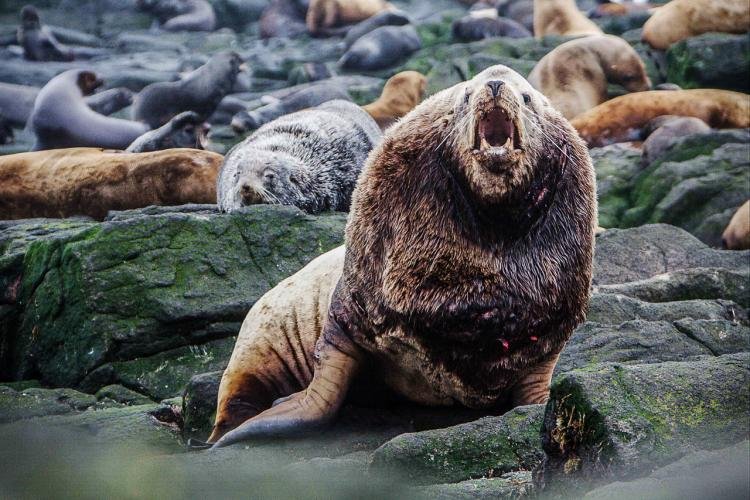Friend Feature: Steller Sea Lions, Eumetopias jubatus
Steller sea lions, Eumetopias jubatus
by Michelle Cartier Homewood, SeaDoc Society
Stellers sea lions hauled out to rest (and grunt and jostle and bite each other) on Whale Rocks in the central Salish Sea. Image by Sarah Teman, SeaDoc Society/San Juan County Marine Mammal Stranding Network
Think BIG
Diagram comparing Stellers sea lions to a Fiat car. Image by NOAA Fisheries.
The Salish Sea is home to the world’s largest species of octopus, jellyfish, sea star, and chiton. But who else is on the list of the LARGEST? That would be the Steller sea lion - the world’s largest species of sea lion! And it’s no small feat to be that big. Adult males grow to be 2,400 lbs. Imagine an animal three times the size of an adult male grizzly bear, and bigger than a small car. Now that’s big!
Mane event
Male Stellers sea lion, showing off a thick mane and roaring his claim to ruling this rock. Anyone up for challenging him? Photo by NOAA Fisheries
Just like male lions in Africa, these male lions of the sea grow long dense fur on their necks. Their scientific name, Eumetopias jubatus, references that shaggy feature - jubatus is Latin for having a mane. Steller sea lions even roar like lions too, and they are loud! You can hear them from miles away. But even with all those similarities to African lions, they are actually closer relatives to bears than lions. Perhaps we should call them Steller sea bears instead?
Bull fight
The large males, called bulls, are territorial and will fiercely defend both their space and their females. These bull fights can get rough, and it is common for them to sustain injuries during these disputes.
Awww. Photo by NOAA Fisheries
Female Steller sea lions only grow to be about 800 lbs, ⅓ of the size of the males, and typically have one baby each year, called a pup. The mother and pup will remain together about a year, and the mother relies on her sense of smell to recognize her pup. By the time the youngster reaches one year of age, they are already as good at swimming and diving as the adults. Impressive! While there are no breeding grounds in Washington, the mothers will bring very young pups to haulouts in the Salish Sea, such as Whale Rocks south of San Juan Island. In general, Steller sea lions don’t migrate, but they do move seasonally to protected haulouts.
Even if you can hold your breath for 16 minutes like this raft of curious Stellers, be sure to never get this close to sea lions underwater without a special permit to do so. It puts you and the sea lions in danger and is against the law in both the US and Canada. Image by David Hicks, Salish Sea in Focus
Dive in!
When humans go underwater, we take a deep breath of air, filling our lungs as much as possible before we go under. Steller sea lions, like other pinnipeds (a sub-group of carnivorous marine mammals including both seals and sea lions), do just the opposite when they dive. They exhale the air from their lungs before going underwater and instead rely on oxygen stored in their muscles. They also slow their heart rate and reduce blood flow to non-essential organs, such as their stomachs.
Steller sea lions can stay underwater for up to 16 minutes and dive 1,500 feet deep. That is more than twice as deep as the Space Needle is tall! During their dives, they are foraging for their dinner of fish, octopus, and squid, or rocks (you read that right - we don’t know why), which they either swallow whole underwater or bring to the surface to break into smaller pieces by whipping their head back and forth (not the rocks. They just swallow them whole. Still don’t know why).
Stellers sea lion healing after marine mammal biologist and a team of sea doctors, Wendy Szaniszlo and team, removed a plastic packing strap from around its neck. Plastic packing bands cause 38% of entangled pinnipeds (seals and sea lions). If you see something, say something. Contact the numbers below.
Image by Wendy Szaniszlo
Curiosity killed the cat
Steller sea lions are curious creatures, but this can get them into trouble when they encounter trash in the ocean. They can become entangled in plastic, especially plastic loops such as fishing nets or packing straps for shipping. Once entangled, they experience painful and even life-threatening injuries. The most common entanglement is when curious sea lions put their heads through loops of floating packing straps. Fun! Then it gets stuck. Then the sea lions grow…and grow. But the strap doesn’t, so it cuts right into their flesh. Not fun! Yes, this happens here in the Salish Sea. But YOU can help!
As a Salish Sea hero, you can make a difference by cutting apart any plastic loops, always throwing your trash in a secured receptacle, picking up debris on beaches, and encouraging others to practice these same good habits.
Have a little more gumption? Put your engineering skillz to work and design a packing strap that won’t choke growing sea lions, then share it with packing materials manufacturers and major shipping corporations so we can, as this linked article shares, "Lose the Loop and Stash the Trash!" Let’s do what we can to protect these stellar giants! Get it? Stellar vs. Steller. Ha.
Report stranded or entangled marine mammals by contacting the numbers below:
NOAA’s West Coast Region Stranding Hotline (for WA, OR, or CA) 1-877-SOS WHAL (1-877-767-9425)
British Columbia Marine Mammal Response Network 1-800-465-4336
You can also report marine mammal incidents via VHF radio on a boat using Channel 16. Press down the talk button, call for the Coast Guard, and describe the incident when they respond.






